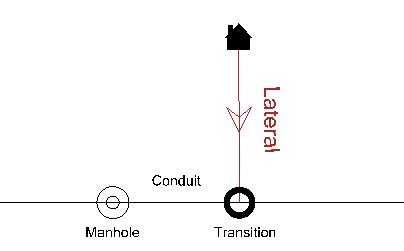| Product(s): |
SewerGEMS, CivilStorm, SewerCAD, StormCAD |
| Version(s): |
10.00.00.40 and later |
| Area: |
Layout and Data Input |

Introduction
The Property connection element was introduced in the CONNECT Edition (10.00.00.40) and is used to load sewer models based on data at the level of individual properties. This is useful when you have loading data provided for all customers/properties based on metering, number of occupants/fixture units, or simply flow per property, and you would like to see it in your hydraulic model (rather than lumping all loads into manholes). This can also enable a closer 1:1 match between the hydraulic model and a GIS.
Licensing
In version 10.01.00.70 and higher, laterals do NOT count toward your license limit. (see "size" under File > Help > About). See: How do OpenFlows product licenses work with element limits? (feature levels)
In older versions (10.00.00.40 and earlier), lateral link elements did count toward your total number of pipes/links.
Layout and Connections
A Property Connection can be placed manually in a model by selecting Layout, then either Property Connection or Lateral.
Property connections can be connected to a downstream gravity network using lateral links. Laterals connect to tap elements and most gravity nodes such as manholes, transitions, and catch basins. Taps can connect to conduits, channels and manholes.
Property connections cannot be connected to pressure elements. Laterals can only make a single connection to a tap or other hydraulic element. Taps cannot connect to a conduit that is designated as a diversion link. There cannot be any hydraulic elements on the upstream side of a Property Connection. However, a Property Connection can be the Outflow Element for a catchment.
Note: see "Calculation Assumptions" below regarding where the flow enters for the hydraulic calculations.
Create Property Connection elements and assign loads
Option 1: A Property Connection can be placed manually in a model by selecting Layout, then either Property Connection or Lateral. The load data for each Property Connection can then be entered in the properties grid or FlexTable.
Option 2: Import Property Connection elements via ModelBuilder (for example using a ShapeFile with billing meter locations), with the loading data attached to the data source. Then use LoadBuilder to assign the property connection flows to the nearest element.
Assigning Property Connections to the Nearest Link
LoadBuilder can be used to assign isolated Property Connection elements to the nearest element by creating a tap and lateral connection. Isolated Property Connections are those elements that are not connected to any lateral element. Laterals are automatically placed between the source element and the hydraulic network when using LoadBuilder and selecting Property Connection Load Data as the Available LoadBuilder Method. When this data source is used, it is assumed that that load data is already available in the Property Connection.
When using the Nearest Pipe method, if the property connection is within 10 feet of a manhole node (perpendicularly), it will be assigned directly to that node directly instead of the pipe. One common situation where this occurs is at a cul-de-sac.
For steps detailing this process, see the following article:
Using LoadBuilder to assign Property Connections to the nearest element while creating taps and/or laterals
Calculation Assumptions
The Ground and Invert Elevation can be entered in the properties of the Property Connection element but are not used in the hydraulic calculations. It is not possible to construct a profile through a lateral link and up to a Property Connection.
Property connections are used for loading in the Explicit and GVF-Convex (SewerCAD) solvers, but are not supported with the Implicit solver. Property connections support hydrograph inflows, pattern loads, or directly accept runoff as the outlet of a catchment. For the GVF-Rational (StormCAD) Solver, flow through a Property Connection must come from a Catchment. (Property Connection designated as the Outflow Element.)
The inflow from a property connection enters the system in the node (for example manhole) on the upstream side of the connected link (conduit or channel).
If you have a situation where there is an important hydraulic difference between the inflow entering the upstream node and entering the upstream end of the pipe (see example below), insert a transition node element near the upstream end of the pipe (where the tap would connect), set the "transition length" to zero, confirm the inverts of the adjacent pipes, then connect the property connection directly to the transition element via a lateral:


Query
The query "Property Connections not connected to Nearest Link" is included in the Network Review Predefined Queries (version 10.00.00.40 and later). This is useful to locate property connections whose loads did not get assigned or are assigned to a pipe that is not closest. To locate completely disconnected property connections, use the query "Orphaned nodes".

See Also
Using LoadBuilder to assign Property Connections to the nearest element and create taps and laterals
Introducing individual Property Connections to your model [VID]
How to toggle tap node dashed line display
Help Article "Property Connections"